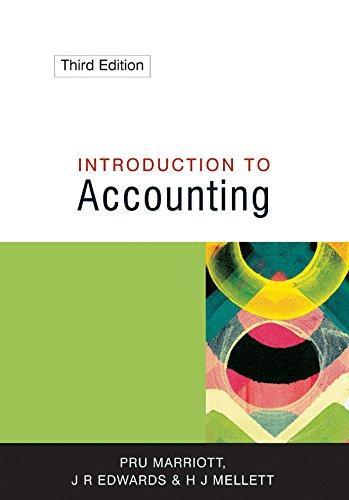6.14 After completing a training course at a technical college, Michael Faraday set up in business as
Question:
6.14 After completing a training course at a technical college, Michael Faraday set up in business as a self-employed electrician on 1 January 19X5. He was very competent at his job but had no idea how to maintain proper accounting records. Sometime during 19X5 one of his friends asked Michael how well his business was doing. He replied, ‘All right … I think … but I’m not quite sure’. In the ensuing conversation his friend asked whether he had prepared accounts yet, covering his first quarter’s trading, to which Michael replied that he had not. Hs friend then stressed that, for various reasons, it was vital for accounts of businesses to be prepared properly.
Shortly afterwards Michael came to see you to ask for your help in preparing accounts for his first quarter’s trading. He brought with him, in a cardboard box, the only records he had, mainly scribbled on scraps of paper.
He explained that he started his business with a car worth £700, and £2,250 in cash of which £250 was his savings and £2,000 had been borrowed from a relative at an interest rate of 10 per cent per annum. It was his practice to pay his suppliers and expenses in cash, to require his customers to settle their accounts in cash and to bank any surplus in a business bank account. He maintained lists of cash receipts and cash payments, of supplies obtained on credit and of work carried out for customers and of appliances sold, on credit.
The list of credit suppliers comprised the following:
Date Amount Date Amount Supplied Supplier Owed Paid Paid Remarks 19X5 £ 19X5 £
Jan Dee & Co 337.74 March 330.00 Received discount
£7.74 AB Supplies 528.20 March 528.20 Feb Simpson 141.34 March 138.00 Received discount
£3.34 Cotton Ltd 427.40 March 130.00 Payment on account April 297.40 Remainder Dee & Co 146.82 March 140.00 Received discount
£6.82 Mar AB Supplies 643.43 April 643.43 Simpson 95.60 Not yet paid The purchase in January from Dee & Co. was of tools and equipment to enable him to carry out electrical repair work. All the remaining purchases were of repair materials, except for the purchase in February from Cotton Ltd that consisted entirely of electrical appliances for resale.
In addition to the above credit transactions, he had bought repair materials for cash, as follows:
19X5 £
January 195.29 February 161.03 March 22.06 Other cash payments comprised:
19X5 £
January Rent of premises for January to June 19X5 400.00 Rates of premises for January to March 19X5 150.00 Stationery 32.70 Car running expenses 92.26 February Sundries 51.54 Car running expenses 81.42 March Sundries 24.61 Car running expenses 104.52 Transfer to bank 500.00 He had also withdrawn £160.00 in cash at the end of each month for living expenses.
The list of credit customers comprised:
Amount Date of sale Customer Amount owed Date received received Remarks 19X5 £ 19X5 £
Jan D. Hopkins 362.80 Feb 357.00 Allowed discount £5.80 P. Bolton 417.10 March 417.10 Feb G. Leivers 55.00 March 55.00 M. Whitehead 151.72 April 151.72 N. John Ltd 49.14 April 49.14 A. Linneker 12.53 March 12.53 Mar E. Horton 462.21 April 462.21 S. Ward 431.08 March 426.00 Allowed discount £5.08 W. Scothem 319.12 Not yet received N. Annable 85.41 Not yet received The above amounts relate to charges for repair work he had carried out, except that the amounts shown in February for G. Leivers, N. John Ltd and A. Linneker are for sales of electrical appliances.
In addition to the above credit transactions, he had cash takings, as follows:
19X5 £
January Repair work 69.44 February Repair work 256.86 March Repair work 182.90 Appliances 112.81 He estimated that, at the end of March 19X5, his stock of electrical repair materials was £691.02 and of electrical appliances for resale was £320.58, his tools and equipment were worth £300.00 and his car £600.00.
Apart from loan interest, the only accrual was for heating and lighting, £265.00.
1 Prepare:
(a) purchases day book with analysis columns for type of purchase; and
(b) sales day book with analysis columns for class of business undertaken.
2 Open, post to 31 March 19X5 only, and balance a columnar cash book suitably analysed to facilitate ledger postings.
3 Open, post to 31 March 19X5 only, and balance a creditors ledger control account and a debtors ledger control account. Use the closing balances in your answer to (7) below.
(N.B. Individual accounts for creditors and debtors are not required.)
4 Open, post and balance sales and cost of sales accounts, each with separate columns for ‘Repairs’ and ‘Appliances’.
5 Prepare M. Faraday’s trading account for the quarter ended 31 March 19X5, distinguishing between gross profit on repairs and on appliance sales.
6 Prepare M. Faraday’s general profit and loss account for the quarter ended 31 March 19X5.
7 Prepare M. Faraday’s balance sheet as at 31 March 19X5.
Step by Step Answer:

Introduction To Accounting
ISBN: 9780761970378
3rd Edition
Authors: Pru Marriott, J R Edwards, Howard J Mellett





